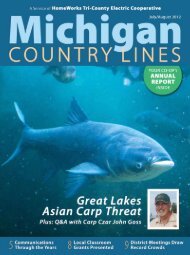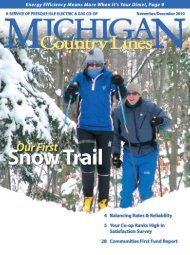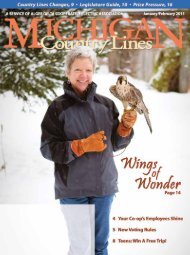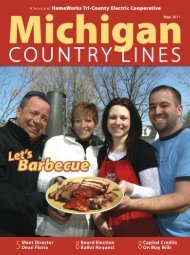Cherryland Electric Cooperative - Michigan Country Lines Magazine
Cherryland Electric Cooperative - Michigan Country Lines Magazine
Cherryland Electric Cooperative - Michigan Country Lines Magazine
Create successful ePaper yourself
Turn your PDF publications into a flip-book with our unique Google optimized e-Paper software.
OUTDOORS | Don Ingle<br />
The ‘Quirky’<br />
Timberdoodle<br />
Saving habitat is key to halting the woodcock’s decline.<br />
The “Timberdoodle” season opens<br />
on Sept. 24, a fact not lost on most<br />
upland bird hunters.<br />
The upland aspen coverts and<br />
wetland tag alder edges of northern <strong>Michigan</strong><br />
have long been the places to seek woodcock.<br />
If you do, remember an old “timberdoodler’s”<br />
hunting advice.<br />
“If you are hunting ‘timberdoodles’ and<br />
don’t get some mud on your shoes, you’re<br />
hunting in the wrong places.”<br />
That’s sage advice to remember in woodcock<br />
season. The key is that, like any other<br />
critter, a woodcock has to eat. If you want<br />
to find deer, you look for acorns; if grouse<br />
are on the agenda, look for gray dogwood,<br />
wild berries and seeds; and for woodcock<br />
you need moist soils because that is where<br />
to find earthworms, the prime food for this<br />
long-billed, stub-tailed little<br />
shorebird that deserted<br />
the marshy beach edges for<br />
northern woodlands.<br />
Woodcock numbers<br />
over their range have been<br />
declining. Most studies,<br />
including the impact of<br />
hunting on their populations,<br />
show clearly that it<br />
is loss of habitat, human<br />
land-use shifts, and lack<br />
of consistent habitat management,<br />
especially on<br />
private forestlands, that<br />
are the major reasons for<br />
this decline—not hunting.<br />
Still, the fall upland<br />
game season will draw<br />
hunters to the northern coverts to seek<br />
this ‘quirky’ bird in those certain habitats.<br />
If they have moist spoils or are close to<br />
wet areas, these are prime places to look up<br />
Seek these types of habitats<br />
as you hunt:<br />
y Aspen stands near moist<br />
lands.<br />
y Under tall bracken fern in<br />
areas of large-bole aspens<br />
and close to opening edges.<br />
y In tag alder thickets along<br />
creeks and wetlands.<br />
Mr. Woodcock.<br />
When we say ‘quirky bird,’ we do not misspeak.<br />
Woodcock come equipped with some<br />
built-in survival abilities, thanks to whatever<br />
divine engineer designed their needs for food<br />
and survival.<br />
First, that long bill; it comes with a special<br />
tip that can grip like pliers to pull up a<br />
worm in a wrap-around motion. The long<br />
bill plunges deep into the soil to grab its<br />
dinner, and it knows just where to stab the<br />
earth thanks to an upside down brain that<br />
puts its ears closer to the ground—great for<br />
detecting worm or grub movements.<br />
Its tail is short and stubby, with a small<br />
ring of white tip marks on the feathers. But<br />
it makes up for its short, squat body with<br />
ultra-wide wings able to reach speeds that<br />
often fool gunners.<br />
Even its voice is quirky—<br />
a nasal “peent” like a tree<br />
frog with a sore throat.<br />
The ‘timberdoodle’ alarm<br />
system is built for survival.<br />
When a potential danger<br />
or predator comes near, it<br />
does one of two things. Sits<br />
tight and lets the markings<br />
of its camouflage feathering<br />
blend in the brushy<br />
autumn ground cover. This<br />
ability to blend in is one<br />
the hunter knows well.<br />
Birds hit and fallen to that<br />
ground cover are hard to<br />
spot. Many a hunter has<br />
stood over a downed woodcock<br />
and not been able to<br />
make it out from the leafy ground debris.<br />
Most serious woodcock hunters usually have<br />
a bird dog that does the finding and retrieving<br />
for them. (The dog also finds and points<br />
live birds when they are still sitting tight.)<br />
Secondly, when flushed, woodcock can<br />
almost seem to hover and fly forward or<br />
backward like a helicopter, but when it is<br />
ready to escape it can suddenly fly at fullflank<br />
speed straight out before towering up<br />
and over the tree line cover. This ability to<br />
toss a whole bag of fight tricks at a hunter<br />
has made shintangle chumps out of skeet<br />
range champs.<br />
Maintaining the habitat of the woodcock<br />
is vital, and not just on public lands. Too<br />
many acres of good habitat are lost to “benign<br />
management”—that is, no management at<br />
all—on private lands. So, enrolling the private<br />
woodlands owner in efforts to maintain<br />
and improve woodcock habitat may be even<br />
more important than on public lands.<br />
<strong>Michigan</strong>’s woodcock hunting season<br />
length and daily bag limits have gradually<br />
been reduced by the Fish and Wildlife Service,<br />
as this bird is a migratory species and<br />
subject to federal game law.<br />
This year, the <strong>Michigan</strong> woodcock hunter<br />
has a 45-day season which runs to Nov. 7,<br />
with a three-bird daily limit, six in possession<br />
after opening day.<br />
While the season is short, it is regarded by<br />
many upland hunters as the most challenging<br />
of game birds just because this ‘quirky’ little<br />
bird always seems to stay a few tricks ahead<br />
of hunters on most days afield. In the end,<br />
it is the challenge of woodcock hunting that<br />
brings the uplander back year after year, not<br />
the number of birds in the bag.<br />
Don Ingle is an avid<br />
outdoorsman and awardwinning<br />
outdoors writer<br />
that submits regularly for<br />
<strong>Country</strong> <strong>Lines</strong>.<br />
Photo – iStockphoto.com<br />
20 | <strong>Michigan</strong> <strong>Country</strong> <strong>Lines</strong>

















